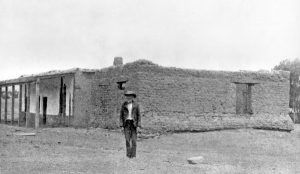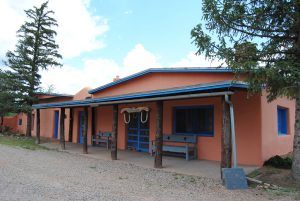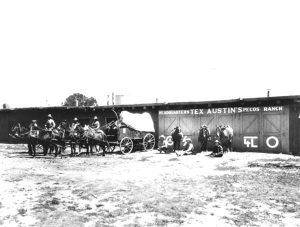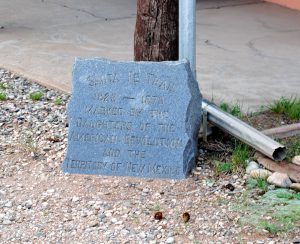Kozlowski’s Trading Post and Stagecoach Stop, located on the Santa Fe Trail just south of the Pecos Pueblo, was a popular place with travelers along the old trail.
At least part of this historic building dates back to 1810, and once the Santa Fe Trail was established in 1821, travelers began to camp at the site due to its proximity to Glorieta Creek and a good spring nearby.
By 1858, Martin Kozlowski purchased the site along with 600 acres. He added onto the existing building, situated on the south side of Glorieta Creek, and established a trading post, hostel, and tavern. Kozlowski’s post was so popular with trail travelers because his wife Ellene often cooked freshly caught trout from Glorieta Creek for customers. Later, the trading post expanded to encompass a stage station for the Barlow and Sanderson stagecoach line.
Martin Kozlowski was born on April 24, 1827, in Warsaw, Poland. He took part in the revolution of his countrymen against the Prussians in 1848 against Germany and was a refugee for two years in England, where he married an Irish woman named Ellene in London in 1853. The same year he was married, the couple immigrated to America, where Martin enlisted in the First Dragoons of the regular army. He was then sent to the southwest to fight the Apache Indians. Between 1854 and 1856, his family moved from Missouri and joined him in New Mexico. He was mustered out in 1858 and used his 160-acre government bounty land warrant to help him purchase 600 acres of ranch land located near a spring on Glorieta Creek.
The number and type of structures that made up Kozlowski’s Trading Post remain unknown, but he would have had to have had living quarters for his family, cabins or rooms for travelers, and space for the trading post and tavern. Outside, he probably had structures for storing grain, stables, and corrals for livestock. He considered the old Pecos Pueblo as his property and used many of the beams adobe bricks for his own building purposes.
In the 1860 agriculture census, Martin Kozlowski claimed 50 improved acres, where he grew corn, and two unimproved acres valued at $1,500, with improvements, livestock, and machinery valued at $200. The Valles, the Kozlowskis, and a New Yorker named James Bugges, were the only non-Hispanics listed in Pecos.
In early 1862 during the Civil War, Confederate troops led an expedition into New Mexico to gain control of the Southwest and the goldfields of Colorado and the ports of California. In March, the Union Army set up headquarters on Kozlowski’s land called Camp Lewis, anticipating a run-in with Confederate soldiers on their way to Fort Union, New Mexico from Santa Fe. Instead, the Battle of Glorieta Pass was fought from March 26-28. After the battle and a couple of months afterward, the army stayed while they treated the sick and wounded. After the army’s stay at his ranch, Martin Kozlowski complimented the Union troops by saying: “When they camped on my place, and while they made my tavern their hospital for over two months after their battles in the canon, they never robbed me of anything, not even a chicken.”
In the 1870 census, Martin Kozlowski was listed as 43-years-old, and his wife Ellene was 42-years-old. At that time, they had six children ranging in ages from two to sixteen. They also employed a live-in washerwoman, a male domestic, and a young household servant. The stagecoach stop had probably made an economic difference in their lives, as they appear more prosperous than they did in the 1860 farm census when they reported the farm and improvements as worth $1,700. In 1870, Kozlowski had real estate valued at $2,000 and a personal estate valued at $800.
From the beginning, Kozlowski’s claim to the acreage upon which his trading post sat was a little shaky, and in 1873, he and another landowner in the area were sued by U.S. Attorney T.B. Catron, claiming they had violated a federal law that prevented non-Indians from settling on pueblo land grants. As a result, Martin and the other owner were ordered to pay $1,000 each. Martin maintained that he bought the land from a man named Johan Piser. Catron’s claim against Kozlowski later became part of a pueblo land case that went to the U.S. Supreme Court, but the trader ultimately retained the land he claimed.
In 1878 Martin Kozlowski shot and killed a man who was arguing with his sons and spent the next two years in the Las Vegas, New Mexico jail.
While Martin was in jail, his wife witnessed the Atchison Topeka and Santa Fe Railroad coming to the Upper Pecos Valley in 1880, which brought an end to the stage stop and made the Santa Fe Trail obsolete. By that time, some of Kozlowski‟s children were living in the new town of Baughl‟s Sidings, where they were listed as the only native New Mexicans.
Somewhere along the line, Ellene moved to Albuquerque to stay with some of her children and died there in 1895. Martin Kozlowski lived at his ranch until 1898 when he joined three of his sons and their families in Albuquerque. The same year, he deeded his ranch property and trading post to his son Thomas. He died in Albuquerque in 1905.
In 1911 Thomas Kozlowski, Martin’s son was back at the ranch, rebuilt some of the structures, and cultivated some land. However, his attempts at reviving the ranch failed, and he lost the land in the 1920s due to a failure to pay taxes.
In 1925, rodeo producer John “Tex” Austin purchased 6,000 acres of the Pecos Pueblo grant, including Kozlowski‟s Trading Post. He soon established the Forked Lightning Ranch as an upscale dude ranch and resort. At that time, Kozlowski‟s trading post was incorporated into the ranch as the foreman‟s quarters. He operated the resort for seven years until the Great Depression hit, and Austin declared bankruptcy and lost the property to the bank in 1932. Texas oilman and rancher Buddy Fogelson bought the spread in 1939, and it became a center for socializing after he married Greer Garson a decade later. After their deaths, the property was sold it to The Conservation Fund in 1991, which donated the land and buildings to the National Park Service.
Today the building is an example of a typical Northern New Mexico vernacular adobe building. It is a one-story, sprawling, U-shaped building, which began as a 600 square foot, one-room structure which was added onto and remodeled for more than a century. Through these additions, the structure grew to approximately 5,000 square feet. The site includes trail ruts from the passing stagecoaches and the trading post/ranch complex building cluster, ornamental plantings, outbuildings, fencing, and historic pasture areas.
The National Park Service provides tours of the Kozlowski Trading Post and Forked Lightning Ranch a couple of times a week, which is the only opportunity to explore the trading post and the Forked Lightning Ranch house.
Pecos National Park is located about 26 miles southeast of Santa Fe, New Mexico. The Kozlowski Trading Post is located on present-day New Mexico Highway 63, just south of the Pecos Pueblo National Historic Park entrance.
Continue your tour of the Santa Fe Trail and the historic, pre-1937 path of Route 66 to the Forked Lightning Ranch.
© Kathy Weiser/Legends of America, updated June 2021.
Also See:
Santa Fe Trail – Highway to the Southwest
Route 66 Pre-1937 Alignment in New Mexico
Sources:
Colorado State University
National Park Service
Whitford, William Clarke; Colorado Volunteers in the Civil War, Colorado State Historical Society, 1906
Victoria Advocate








